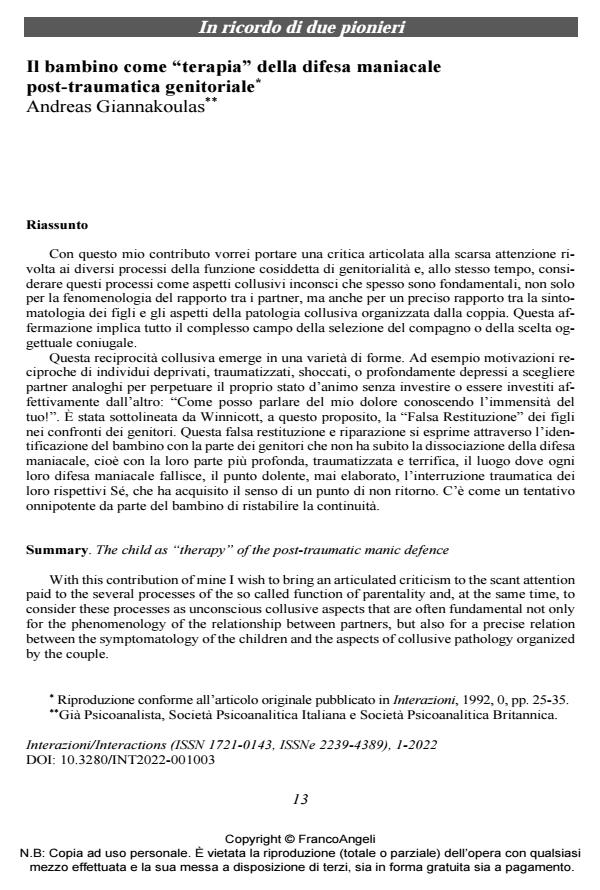The child as "therapy" of the post-traumatic manic defence
Journal title INTERAZIONI
Author/s Andreas Giannakoulas
Publishing Year 2022 Issue 2022/1
Language Italian Pages 13 P. 13-25 File size 174 KB
DOI 10.3280/INT2022-001003
DOI is like a bar code for intellectual property: to have more infomation
click here
Below, you can see the article first page
If you want to buy this article in PDF format, you can do it, following the instructions to buy download credits

FrancoAngeli is member of Publishers International Linking Association, Inc (PILA), a not-for-profit association which run the CrossRef service enabling links to and from online scholarly content.
With this contribution of mine I wish to bring an articulated criticism to the scant attention paid to the several processes of the so called function of parentality and, at the same time, to consider these processes as unconscious collusive aspects that are often fundamental not only for the phenomenology of the relationship between partners, but also for a precise relation between the symptomatology of the children and the aspects of collusive pathology organized by the couple. This statement implies the whole complex field or the choice of the partner. This collusive mutuality emerges in a variety of forms. For example, mutual motivation of deprived, traumatized, shocked or deeply depressed individuals, to choose similar partners in order to perpetuate their mood without investing or being invested affectively by the other: "How can I speak of my own grief knowing the immensity of yours!". In this connection, Winnicott pointed out the "False Restitution" of the children towards the parents. This false restitution and reparation espressi t self through the identification of the child with the part of the parents that did not went through the dissociation of manic defence of theirs fails, the painful core, never worked through, the traumatic interruption of both their selves, that senses like a non turning point. There is in the child a sort of omnipotent attempt to reestablish continuity.
- Pontalis I.B. (1977), Entre le rêve et la douleur, Editions Gallimard, Parigi (tr. it., Tra il sogno e il dolore, Borla, Roma, 1991).
- Winnicott D.W. (1935), La difesa maniacale, in Dalla pediatria alla psicoanalisi, Martinelli, Firenze, 1975.
- Balint M., Balint E. (1959), Thrills and Regression, in La regressione, Cortina, Milano, 1983.
- Balint M., Balint E. (1968), The Basic Fault, in La regressione, Cortina, Milano, 1983.
- Dicks H. (1977), Marital Tensions, Routledge-Keagan, London.
- Freud S. (1917), Lutto e melanconia, in Opere, voI. VIII, Boringhieri, Torino, 1976.
- Giannakoulas A., Giannotti A. (1984), Il setting con la coppia genitoriale, in Il setting, Borla, Roma.
Andreas Giannakoulas, Il bambino come "terapia" della difesa maniacale post-traumatica genitoriale in "INTERAZIONI" 1/2022, pp 13-25, DOI: 10.3280/INT2022-001003